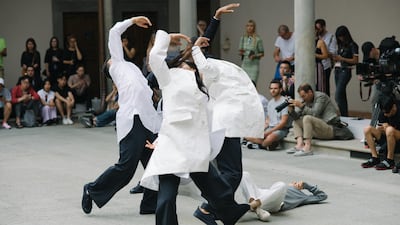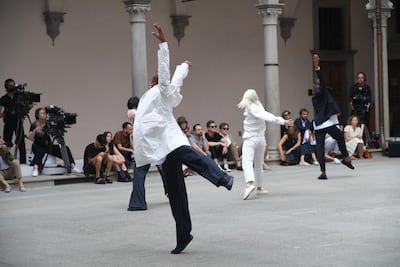When I received an invitation to attend Cos's debut menswear show at Pitti Uomo 94, I expected another round of well-dressed male models stomping a runway, wearing looks that ranged predictably from streetwear to suits.
What I was not expecting was a dance piece – but this was precisely what was delivered by Cos's new head of menswear, Christophe Copin. Entitled Soma (meaning body in Greek), the dance was orchestrated by Wayne McGregor, resident choreographer for The Royal Ballet.
In the quiet sanctity of the walled Istituto degli Innocenti in Florence, Copin chose to forgo the standard format of a fashion show, and instead sent out nine dancers clad in his new spring/summer menswear collection. "This was not a fashion show," Copin tells me afterwards. "It came very naturally. We started to work on the idea of an essential collection for menswear, and the starting point was everyday movement; movement that is absolutely understated."
To demonstrate what he means, Copin tugs at an imaginary cuff, touches his fingers to his collar, and absent-mindedly pushes up his sleeve, mirroring the tiny movements that we make every day, and to which we rarely give thought. "When we thought about the collection, it was based on this very understated idea that couldn't be presented as a fashion show – that was not the purpose of it. It was based on just a routine movement."
As a debut at Pitti Uomo, Milan Men’s Fashion Week’s smaller and less brash cousin, this new approach to a show signified a bold change of thinking. “When we wanted to work on this idea of movement – even if it is little movements – we thought that the best person to work with had to be a choreographer, a dancer. He works with the body, with movement, and our first choice was Wayne McGregor because we are big fans of his work,” Copin explains.
“I have seen some ballets by him, and he has been on my mind for a long time. We explained the idea of this collection – about this idea of small movements. The collection was already almost completely designed, and he really loved the idea of having to work with something already existing. For us it was different, because we started with the movement, while for him, he started with the garment. It was really interesting to have this inverted role.
“There have been, I am sure, restrictions in the clothes, but the challenge in the beginning was for us not to modify any clothes for the performance. The dancers have to wear the clothes, and adapt themselves and the movements to the silhouette that we put on each of them. So it was a complete collaboration, and an amazing one.”
_____________________
Read more:
MCM steals the show at Pitti Uomo 94
Fashion shoot: High fashion aboard the Queen Elizabeth 2 - in pictures
Exclusive: digital paintings by Spain's Ignasi Monreal for Gucci
The key looks and trends in menswear from Pitti Uomo
_____________________
As the performance unfurled in front of its Pitti Uomo audience, we watched, somewhat spellbound, as the dancers turned and twirled, in tight, restrained motions, around the ancient space, clad in the disarmingly simple clothes that Cos excels at. As the dancers moved, each piece of clothing folded and creased, gaining personality as the choregraphy progressed. In addition, as quickly became clear, despite being a men's collection, the pieces were in fact almost unisex.
“We never design saying: ‘OK, let’s make part of the collection unisex.’ There is nothing like that, but there is something about our creative process that is connected to modernity, connected to functionality, to tactility, that speaks to both men and women. We try, when working on a suit, a shirt, or on length and proportion, to be as simple as possible, and erase what is an accessory. Maybe that’s why it belongs to men and women,” he explains.
However unintentionally, this genderless aesthetic is at the very heart of the brand's success. Inherently pared back, Cos pieces do not shout, which is appealing to those who prefer their style to be softly spoken. Always favouring a muted palette, and in shapes that echo rather than display the body, the effect is pieces that are seasonless, and collections that refuse to be pinned down in time.
"To be timeless is not only to be wearable now and in two or three years; timeless also means working on the quality," he explains. "That is part of us, that is something we pay a lot of attention to, because if you want to wear it for a long time, it has to have good quality on fabric, on every detail. We have to work a long time to achieve that, and it is a very important part of our work."
For Copin, such an outlook is hardly new. Prior to this venture, he has been head of menswear for Maison Margiela (from 2011 to 2014), senior men’s knitwear designer at Hermès (2011) and fabric designer for Balenciaga (2001 to 2002). He also launched his own label, Jauge Sept, and worked as a design consultant for Yeezy. With such pedigree, his astute eye for detail is hardly surprising. What is unexpected, however, is to translate this level of quality for an upscale high-street brand.
“It is a challenge, of course, but a challenge that is absolutely part of us – that we find very important to focus on. We pay a lot of attention to quality; the big difference is that the price you find in store is super-affordable, which is really incredible for me. I can see people in the street wearing clothes we designed in the office, and it’s a big gift; it’s a very nice feeling.”
As the dancers began their performance, it was accompanied by a muffled rhythmic noise, a hypnotic to-ing and fro-ing of sound that I first took for waves on the shore. "When we did the first rehearsal at Wayne's studio, it was with the first prototypes of the clothes and there was no music at that time. So [the dancers] tried the clothes and started to improvise and move with the clothes, and we just looked at them walking, and we heard the sound of the step and the sound of the moving fabric, of the garment in movement. So it came very naturally to both Wayne, Karin [creative director at Cos] and I to use that sound for the music, and that is what you hear at the beginning."
As well as holding a fashion audience captivated (itself no mean feat), presenting a dance piece had another, unexpected effect. With no final parade of models to film, the audience put down their phones, and took the time to actually stop and observe. With empty hands for once, it meant that as the show drew to an end, the long forgotten sound of applause filled the entire space.
“I was backstage, but we watched the performance on the screen, and there was something very special in the sound,” says Copin. “It was a magical moment for us.”



